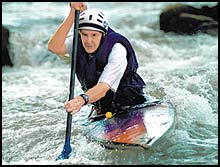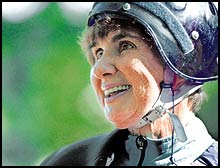More Fit Than Ever


Carter Hearn and Ursy Potter, his spouse
Photos by Shawn Thew, The Washington Post
By Susan Levine
The Washington Post
Health Seniors special issue
Tuesday, July 20, 1999; Page Z18
Catching Carter Hearn and Ursy Potter at home is an iffy proposition. If the husband and wife, pictured above, are not out kayaking on the Potomac River -- maneuvering the slalom gates in the feeder canal at Brookmont or slipping between the rock islands at Little Falls -- they may be running the Youghiogheny south of Pittsburgh. If not there, they're tackling whitewater elsewhere in Pennsylvania or perhaps in Colorado.
Or Montana.
Or Costa Rica.
Or Mexico, which is where a photograph was snapped last winter as Potter shot down a 15-foot waterfall on the Micos River, paddle clenched overhead in two-handed triumph.
It's exercise rarely associated with couples beyond the midpoint of their sixties, as others occasionally point out. "Hey, you're in a kayak instead of a wheelchair!" they tell Potter, with only slightly exaggerated incredulity.
But why not? At a time when this country's seniors are more fit than ever, and involved in vigorous sports from marathoning to rock climbing, why wouldn't there be older men and women who tuck themselves tight and low into plexiglass slivers, racing rapids, igniting adrenaline, pushing limits and having a simply grand adventure?
"I feel like I'm still learning every time I go out," said Hearn, a geologist who got hooked nearly four decades ago -- and in turn hooked two of his children, who became world-class competitors. A long, lean man, he paddles more at 66 than in his younger years. Some days, the goal is sheer pleasure.
"It's fun being out on a river," he explained. "It's so beautiful."
In this part of the world in particular, the McLean couple have plenty of company. Of the more than 800 members of the Canoe Cruisers Association -- perhaps the largest paddling group in the Washington area and composed of both kayakers and traditional canoeists -- nearly half are at least 50 years old. Several dozen members are at least 70.
The situation elsewhere is similar. At USA Canoe/Kayak, the governing body of American paddling competition, spokeswoman Lisa Fish said anecdotal evidence suggests increasing numbers of older kayakers. At certain distance events, she said, "a lot of parents are there [racing] with their kids." Some also enter as masters in national sprint and slalom competitions.
Canoe Cruisers Association president Larry Gladieux, 55, who grew up on flat water in the Adirondacks, got into kayaking nine years ago. He took one of the association's beginner courses on the Potomac and over a winter learned to do 360-degree Eskimo rolls in an indoor swimming pool. Today, to his wife's dismay, he keeps three kayaks in their Alexandria townhouse.
"It's the closest thing to making like a fish," he said, his zeal breaking the surface of his conversation. "You try to master the water, and it's always undulating, always changing."
And given that he goes out at least twice a week, kayaking is also easier than other activities on the left knee he had replaced two years ago. Next month, during a vacation from his job as a policy researcher for the College Board, he will paddle for seven days on rivers throughout Quebec.
"I try to stay in shape," Gladieux said. "I hope I can be doing this into my eighties."
There's little way an enthusiast can do much paddling and not start bringing muscles and most other parts of the body into line. An hour of kayaking burns hundreds of calories. It works the back and abdominal muscles, the biceps and triceps. It requires not just upper-body strength but significant flexibility through the torso. How else to power your 13-foot craft through a boulder-strewn course or pivot against the current to speed through a gate?
"I was ready to die about 12 years ago," confessed Star Mitchell, a retired Montgomery County teacher. Here's another confession: Mitchell is 62, although she is ambivalent about revealing that. On the one hand, "I paddle with all these young men, and I don't want them to know," she said. On other hand, when they learn her age, they're nothing but impressed. "You're awesome," they rave. "I sure hope I'm doing that when I'm your age."
Yet a dozen years back, beset by asthma and other medical problems, as well as by the pressures of aging parents, truculent teenagers and a divorce, that wasn't the case. Mitchell said she turned her life around through health food, vitamins -- and kayaking.
"I love the euphoria you get from it, the endorphins," she said. "I should go work out at the Y, but it's so boring. But I can sit and paddle my boat all day. You just get out there on the river and you forget everything."
The Bethesda grandmother is a flashier kayaker than most. She likes to color-coordinate her helmet, life jacket, spray skirt and kayak -- yellow; red and black if she's taking out one boat; or purple, yellow and red if she's taking out the other.
Endorphins aside, her sport does have negatives. She's suffered through some bad, decidedly unplanned swims in cold rivers and gotten banged up against rocks. And hauling her gear to put-in or take-out points is getting more onerous. With equipment, a kayak may push the scales to 50 pounds. "As I get older, they get heavier and heavier," Mitchell conceded.
The weight doesn't seem to bother 64-year-old Don Besom, a retired Foreign Service officer who has paddled all over the world. In the last four years he's logged 2,000 miles on the Missouri River and 575 miles on the Yellowstone. The latter would have been a mere day trip by comparison had he not miscalculated the first dam and, in aiming for a side chute, plunged directly over the top. Trapped as the water churned down and around, his sea kayak ripped away from him, Besom survived somehow and even caught up with his boat a mile or two downstream. And then finished his solo journey.
"I sort of enjoy pushing myself," he said, a glaring understatement offered while day-tripping the drought-diminished Potomac not far from his Glen Echo home earlier this month.
Besom is tanned and wiry and given to tying a red bandanna around his head on a sweltering summer day. "There are a lot of aging warriors, aging paddlers, in this area," he said, and while he belongs in that group, in part because of the half-dozen races he runs each year, his love of kayaking flows deeper. "It's a more complete sort of interaction with the environment, with the river." A conditioning and a challenge, yes, but also a philosophy and attitude. He has no plans to quit any time soon.
Nor does Hearn. Nor does Potter. Although her career lies in pottery, her license plate reads RIVR BUM. "Paddling is something we do to clear our minds of the riffraff," she said.
The couple tends to kayak together. Locally, they head to Brookmont in Montgomery County, putting in near Lock 6 on the C&O Canal and warming up on the training gates just upstream. Hearn, in a boat glimmering purple, rose and blue, pulls with strong, sure strokes. His wife -- who is reticent about her exact age -- lacks his reach and experience but compensates with a jaw-set determination, purple helmet cutting in and out of the eddies and froth.
"The fact is that I have a lot of energy," Potter said, dark eyes flashing, "I could never just sit and go 'ooom.'"
© 1999 The Washington Post Company
![]()

